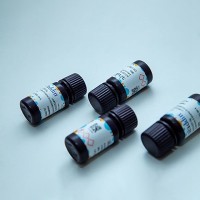Primed In Situ Nucleic Acid Labeling Combined with Immunocytochemistry to Simultaneously Localize DNA and Proteins in Cells and Chromosomes
互联网
651
In the past decade, the primed in situ (PRINS) labeling technique has become an alternative to fluorescence in situ hybridization (ISH) for the localization of nucleic acid sequences in chromosome, cell, and tissue preparations (1 –8 ). The PRINS method is based on the rapid annealing of unlabeled primers (restriction fragment, PCR product, or oligonucleotide) to complementary target sequences in situ . These primers serve as initiation sites for in situ chain elongation using Taq DNA polymerase and labeled nucleotides. Incorporated fluorochrome-labeled nucleotides can be detected directly by fluorescence microscopy, whereas haptenized (e.g., biotin, digoxigenin, dinitrophenyl) nucleotides can be visualized by the additional application of fluorochrome- or enzyme-conjugated avidin or antibody molecules (4 ,5 ,9 ,10 ), followed by fluorescence microscopy or brightfeld visualization of enzyme reaction products. Particularly, rapidity, simplicity, and cost-effectiveness have made the PRINS technique a useful tool in cytogenetics and cell biology. Its detection sensitivity, however, seems to be limited to repetitive targets for a long time. Only recently, the combined use of multiple oligonucleotides for 1 locus together with tyramide signal amplification have shown the first reproducible results demonstrating single-copy gene detection by PRINS (11 ).





![DKFZ-PSMA-11,4,6,12,19-Tetraazadocosane-1,3,7-tricarboxylic acid, 22-[3-[[[2-[[[5-(2-carboxyethyl)-2-hydroxyphenyl]methyl](carboxymethyl)amin](https://img1.dxycdn.com/p/s14/2025/1009/171/0405943971658126791.jpg!wh200)



